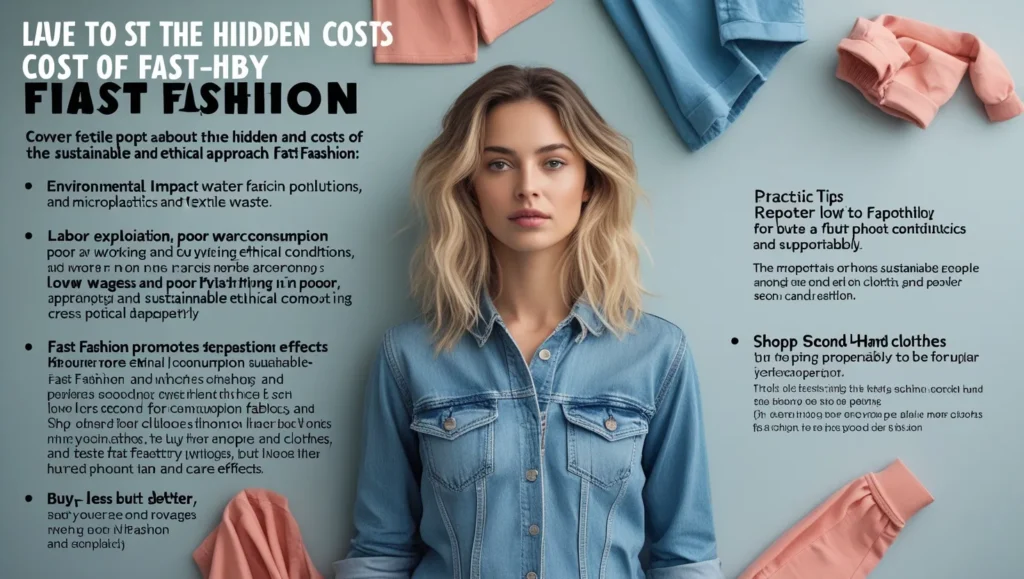The Hidden Costs of Fast Fashion
Fast fashion has become a dominant force in the retail industry, The Hidden Costs of Fast Fashion offering trendy and affordable clothing at an unprecedented pace. While the appeal of low prices and rapidly changing styles is undeniable, the true cost of fast fashion extends far beyond what meets the eye. Behind the scenes, it takes a heavy toll on the environment, exploits workers, and promotes unsustainable consumption habits. Understanding these hidden costs can help us make more responsible choices as consumers.
The Environmental Impact of Fast Fashion
One of the most significant drawbacks of fast fashion is its environmental footprint. The industry is responsible for nearly 10% of global carbon emissions, The Hidden Costs of Fast Fashion making it one of the biggest polluters worldwide. The following environmental issues are closely linked to fast fashion:
- Water Consumption and Pollution – Producing clothing requires enormous amounts of water. For instance, a single cotton T-shirt takes approximately 2,700 liters of water to make. Additionally, textile dyeing is one of the largest contributors to water pollution, as untreated chemical waste from factories often ends up in rivers and oceans, harming aquatic ecosystems and communities that depend on clean water.
- Microplastic Pollution – Synthetic fabrics such as polyester, nylon, and acrylic shed microplastics when washed. These tiny plastic fibers enter the water supply, ultimately making their way into oceans and even the food chain.
- Waste and Landfill Overload – The fast fashion model encourages frequent wardrobe changes, resulting in an enormous amount of textile waste. According to studies, more than 85% of all textiles end up in landfills each year. Since synthetic fabrics are not biodegradable, they persist in the environment for decades.
Labor Exploitation in the Fast Fashion Industry
Fast fashion brands often rely on cheap labor to keep costs low, The Hidden Costs of Fast Fashion and unfortunately, this has led to widespread human rights violations in the industry. Some key issues include:
- Poor Working Conditions – Many garment workers, especially in developing countries, work in unsafe conditions with little to no labor protections. The 2013 Rana Plaza disaster in Bangladesh, where over 1,100 workers died when a factory collapsed, highlighted the extreme dangers faced by workers in the fast fashion industry.
- Low Wages – Workers in fast fashion supply chains are often paid far below a living wage, making it difficult for them to support their families. Some factories even engage in forced labor and child labor practices.
- Excessive Work Hours – To meet the high demands of fast fashion retailers, workers are often forced to work long hours under intense pressure. In many cases, they are denied basic rights such as rest breaks and fair compensation for overtime.
The Culture of Overconsumption
Fast fashion promotes a culture of excessive consumption, The Hidden Costs of Fast Fashion where clothing is treated as disposable. With new trends emerging every few weeks, consumers are encouraged to buy more, often at the expense of quality. This has several negative consequences:
- Short Lifespan of Clothing – The low-cost nature of fast fashion means that garments are not designed to last. Poor-quality fabrics and stitching result in clothing that quickly loses its shape, fades, or falls apart after just a few washes.
- Psychological Impact – The constant bombardment of new trends can create a sense of dissatisfaction with one’s wardrobe, leading to impulsive purchases and unnecessary spending.
- Financial Waste – While fast fashion seems affordable, repeatedly buying low-quality items adds up over time. Investing in higher-quality, durable clothing can be more cost-effective in the long run.
How to Shop Responsibly
Now that we understand the hidden costs of fast fashion, The Hidden Costs of Fast Fashion how can we make more responsible choices as consumers? Here are some practical steps:
- Buy Less, Choose Better – Shift your mindset from quantity to quality. Instead of buying multiple cheap items, invest in well-made, timeless pieces that will last longer and withstand wear and tear.
- Support Ethical Brands – Look for brands that prioritize fair wages, safe working conditions, and sustainable materials. Certifications like Fair Trade, GOTS (Global Organic Textile Standard), and B Corp can help identify ethical fashion brands.
- Opt for Sustainable Fabrics – Natural fibers like organic cotton, linen, hemp, and Tencel are more eco-friendly alternatives to synthetic materials. Recycled fabrics also help reduce waste.
- Embrace Second-Hand and Thrift Shopping – Shopping at thrift stores, consignment shops, and online resale platforms is a great way to reduce waste and extend the life of clothing. You can find unique, high-quality pieces at a fraction of the price.
- Care for Your Clothes Properly – Extend the lifespan of your clothing by washing them in cold water, using gentle detergents, air drying, and repairing minor damages instead of discarding them.
- Participate in Clothing Swaps and Recycling Programs – Many communities and brands offer clothing swap events where you can exchange items with others. Some retailers also have recycling initiatives that allow you to drop off old clothing for proper disposal or repurposing.
- Resist Impulse Buying – Before making a purchase, ask yourself if you truly need the item, if it matches your existing wardrobe, and if it is made ethically. Taking a more mindful approach to shopping can help curb unnecessary consumption.
Final Thoughts
Fast fashion may offer affordability and accessibility, The Hidden Costs of Fast Fashion but its true costs are far-reaching, affecting the environment, workers, and our own consumption habits. By being more mindful of where and how we shop, we can contribute to a more sustainable and ethical fashion industry. Every small step, whether it’s choosing quality over quantity, supporting ethical brands, or embracing second-hand fashion, makes a difference. Responsible shopping is not just about looking good—it’s about making choices that benefit people and the planet.

